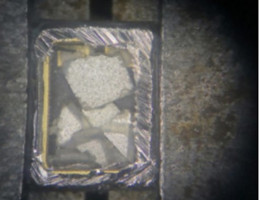How to avoid the effect of ultrasonic soldering waves on the crystal oscillator?
With the combination, upgrading, and popularisation of artificial intelligence and various types of sensing terminals,
more and more electronic devices with wireless transmission functions are beginning to be widely used in the Internet,
smart homes, intelligent agriculture, animal husbandry, forestry, intelligent elderly care and other fields.
In order to achieve intelligent positioning, temperature measurement, health monitoring, image monitoring,
real-time data capture, aggregation and analysis and many other functions.
Currently, there is a growing trend to use ultrasonic sealing to seal the circuit board of the built-in crystal oscillator,
such as Bluetooth positioning chest card, outdoor Bluetooth control lights, Bluetooth temperature measurement and positioning ear tags.
The common package sizes for Bluetooth crystals oscillator are SMD3225 and SMD2016, with common frequency points of
16MHz, 24MHz, 26MHz, 32MHz, 37.4MHz, 40MHz etc. The common small size low power Bluetooth crystal oscillator load is:
7pF, 8pF, 9pF, 10pF and 12pF, but no low power requirements of the Bluetooth device is commonly used 20pF load,
crystal oscillator accuracy requirements: ± 10ppm, operating temperature: -20 ~ +70 or -40 ~ +85.
The main reasons for the destructive effect of ultrasonic soldering on the crystal oscillator are as follows:
Irregular use of ultrasonic waves may damage the quartz wafer inside the crystal oscillator
(the chemical composition of the wafer is silicon dioxide, the same as glass, which is a brittle and fragile product),
causing the crystal to stop vibrating

(SMD crystal oscillator internal quartz chip shattered by ultrasonic waves)
2.Irregular use of ultrasonic waves may crack the fixation point between the quartz chip and the base - the conductive glue,
resulting in a broken circuit inside the crystal oscillator and the crystal oscillator stopping vibrating.
So how do we avoid the effects of ultrasonic soldering on crystal oscillator?
In fact, many crystal factories do not recommend the use of ultrasonic sealing of crystal oscillators.
Based on the strong demand from customers for ultrasonic encapsulation, such as the advantages of low cost,
high efficiency and good water resistance, our company has made effective progress in the field of ultrasonic crystal oscillator development.
In addition to advising our customers to follow strict ultrasonic protocols for ultrasonic packaging,
we have also optimised the design of the quartz wafer and crystal oscillator base bonding strength in multiple dimensions.
In actual batch product testing on the client side, the defective crystal rate has improved significantly
from a few percent to within an acceptable range of a few thousandths.
